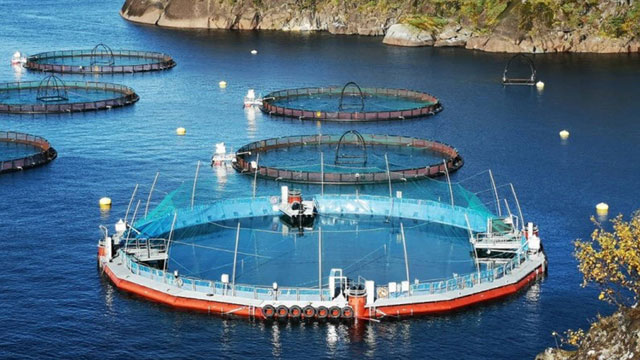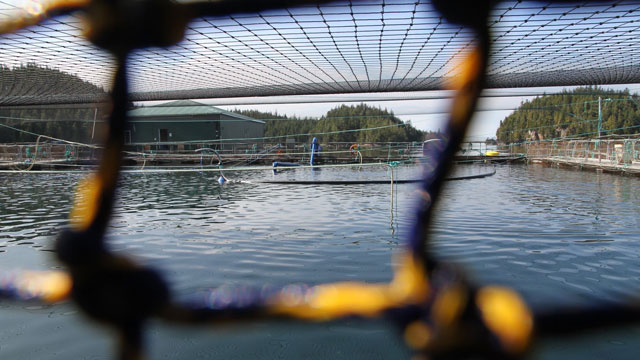
Laurie Hamelin
APTN News
Communities involved in the fish farm industry in British Columbia are anxious for the new federal minister of Fisheries and Oceans to get up to speed on all things salmon farming.
On Nov. 20, Prime Minister Justin Trudeau appointed Nova Scotia MP Bernadette Jordan as his new fisheries minister replacing Vancouver MP Jonathan Wilkinson who was given the Environment and Climate Change portfolio.
The new parliament officially gets underway Dec. 5, with a speech from the throne and for people on the coast of British Columbia, it can’t come soon enough.
“There’s a lot at stake here and a lot of questions that need answered,” says Chief John Smith of Tlowitsis First Nation on East Vancouver Island.
During the federal election campaign, the Liberal’s promised to transition from open-net salmon farms to closed containment systems in B.C. by 2025.
The promise not only shocked the aquaculture industry, but also First Nations.
Smith says he immediately sent Trudeau a letter with his concerns, but hasn’t heard back.
“I was in Ottawa last year and thought we had a good understanding, but the government didn’t consult with us before their announcement,“ says Smith.
“I plan on going to Ottawa as soon as we can organize a meeting.”
The Tlowitsis Nation has an agreement with Grieg Seafood and currently have 3 open-net salmon farms in their traditional waters – and are hoping for a fourth.
“We want one more,” says Smith.
“These fish farms provide generously for us and we are very pleased with our relationship with Grieg. They not only pay us rent in respect to our Title, they have always respected us.”
Farm raised salmon generates $1.5 billion towards the B.C. economy.
Indigenous employees make up 20 per cent of the 7,000 jobs with three quarters of the harvest comes from partnership agreements with First Nations.
(Farmed Atlantic salmon. Photo courtesy: Mowi)
The B.C. Salmon Farmers Association (BCSFA) was also caught off guard by the Liberal’s election promise.
BCSFA is part of a special advisory group that John Wilkinson, the former federal fisheries minister put together to look at the current salmon farming industry and new aquaculture technologies – and later commissioned a report.
“For almost a year we have been engaged in an aquaculture technology review process that the fisheries minister himself had invited us into, along with other stakeholders, interest groups and provincial and federal government,” says John Paul Fraser, executive director of the BCSFA.
“Never once was an arbitrary date put on the table and certainly did not prioritize closed containment over all the others.”
Fraser says that he was under the impression that hybrid systems were looking like the best option for B.C.
“We looked at closed containment in the ocean, closed containment on land, ocean based systems that are large cased systems deeper out in the open ocean and what’s called hybrid, which is two forms, a land-based and ocean raised system where the salmon would be reared for longer periods on land,” he said.
‘That is probably the most common trend globally right now and as the group’s work was ongoing it was looking like the most practical, feasible trend for our coast.”
But Chief Don Svanvik of the ‘Namgis First Nation off North Vancouver Island says land-base fish farms are the only option for protecting wild salmon.
“If Canadians care about wild salmon then fish farms have to be moved to land,” says Svanvik.
Many First Nations and environmental groups believe wild salmon migrating past fish farms are exposed to disease, pathogens and higher concentrations of sea lice spewing from open-net pens.
The use of pesticides and antibiotics are also a concern on the marine environment.
The science debate has been hard-fought on all sides and has long divided many people in B.C. and around the world.
But Svanvik says there’s no disputing that wild salmon in B.C. are in trouble.
“Salmon stocks are critically low,” says Svanvik. “Many things can affect our wild salmon and open-net pens are one of them so we have to try everything we can.”
Svanvik was pleased to hear the Liberal’s pledge to transition to closed containment, but says he wants more clarification.
“I would like the plan to be more defined because closed containment doesn’t always mean entirely closed off from the ocean, some can still impact wild salmon and the environment,” he said. “It’s important that the pens are taken out of the ocean completely.”
In 2012, the ‘Namgis began building Kuterra, the first commercial, pilot-scale land-base Atlantic salmon farm in North America.
The facility was built near Port McNeil on North Vancouver Island with government and charitable funding, including money from the ‘Namgis themselves.
Capital costs were $10 million and with operating costs the total investment was about $15 million.
Not cheap for a small-scale research project, but the outcome has big potential.
Garry Ullstrom, Kuterra’s former CEO explains that growing Atlantic salmon to market size had never been done before.
“The project was created to prove the technical, biological and economic feasibility of raising Atlantic salmon on land to market size using recirculating aquaculture systems (RAS),” says Ullstrom.
“It was built specifically to answer a ton of questions that were out there. To prove real data like how fast do the fish grow, how much feed is needed, what is their health condition going to be like, what is the quality of the fish going to be, what kind of price can we get for these fish, etc.”
And after five years of full operation, the facility produces 250 metric tonnes of salmon per year and is breaking even.
Although the project has not yet been profitable, Svanvik says he’s proud of the work his nation has done at Kuterra.
“It’s a new technology and it works,” says Svanvik. “It took Kuterra and a handful of other pilots to show the way. The things that have been discovered, to fine tune the technology, you know that information has been shared around the world.
“There are now land-base farms being built all over.”
According to Kuterra’s website, there are now 60 land-based Atlantic salmon farms either announced, operating, in design or under construction across the planet.
Atlantic Sapphire, a large full-scale facility in development in Florida is on course to deliver its first harvest in 2020.
Svanvik says the U.S. farm expects to grow 90 thousand tonnes of salmon a year on a 33 hectare sight.
“That’s almost as much as all of B.C. grows on a piece of land smaller than a kilometre,” says Svanvik.
But the BCSFA is cautious and says innovation follows certainty around growth.
“The diversification that is happening with land-base systems is positive, but we are at the very early stages of all of this,” says Fraser.
“There are examples globally, but it is the very early days and very little has been proven in terms of economic viability. B.C. produces 85 thousand tonnes per year on average. That’s a billion dollar change just to keep the status quo.”
(Open net salmon farm off North Vancouver Island. Photo: Facebook)
And what about the nations that now have partnership agreements with industry, but don’t have what it takes for a land-base farm?
Smith’s community near Campbell River could loose $1 million a year if the farms are moved to land.
“Our territory is not suitable for land-base farms,” says Smith. “We’re too far out and we don’t have the power supply.”
But Bob Chamberlain, the former vice president of the Union of B.C. Indian Chiefs, questions whether or not the transition will ever actually happen.
Chamberlain ran in the recent federal election as the NDP candidate for Nanaimo-Ladysmith and has long been opposed to open-net salmon farms.
“The Liberals did not support Fin Donnelly’s closed containment bill in the last government,” says Chamberlain.
“So here we have a government while in power with an absolute majority and they did not go to closed containment, but come election time quickly changed their minds,” he said.
“The work that Wild Salmon Forever had done in their Save Our Salmon campaign where they had MP’s sign up declaring they would call for closed containment, I think that had something to do with the Liberals changing course.”
Wilkinson announced the campaign promise on Oct. 2 in West Vancouver. It reflected a precautionary approach to a divisive issue in B.C. over the protection of wild salmon.
“A re-elected Liberal government will look at all feasible technologies and the transition to closed containment will carefully consider economically-feasible approaches,” said Wilkinson.
“Our goal is to work with the province, First Nations, industry, communities and workers to develop new approaches that will allow British Columbia to become a world leader in closed containment, thereby securing the jobs and sustainable economic opportunities that come with this innovation.”
Trudeau’s decision to remove Wilkinson and appoint Jordan as the new Fisheries Minister is another reason Chamberlain doubts the Liberals pledge.
“I wonder if it was strategic to move the discussion on closed containment further down the road,” says Chamberlain.
“If it was still Wilkinson we could just pick up and keep going on this right now with no delays.”
@laurie_hamelin











